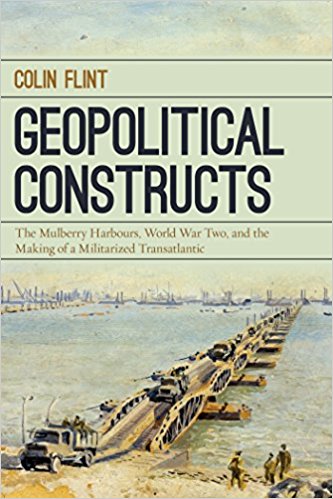
Geopolitical Constructs: The Mulberry Harbours, World War Two, and the Making of a Militarized Transatlantic by Colin Flint
 The D-Day invasions loom large in the history and memory of World War II, Europe, and the United States. As Colin Flint suggests, “we can all conjure up images of the event, either from photos and descriptions from the many books written on the topic, or from the host of Hollywood depictions, from The Longest Day to Saving Private Ryan” (1). And in that representation, the soldiers who stormed the beaches of Normandy, on their way to liberating Western Europe, rightfully play a central role.
The D-Day invasions loom large in the history and memory of World War II, Europe, and the United States. As Colin Flint suggests, “we can all conjure up images of the event, either from photos and descriptions from the many books written on the topic, or from the host of Hollywood depictions, from The Longest Day to Saving Private Ryan” (1). And in that representation, the soldiers who stormed the beaches of Normandy, on their way to liberating Western Europe, rightfully play a central role.
Yet, Colin Flint, in his new book Geopolitical Constructs: The Mulberry Harbours, World War Two, and the Making of a Militarized Transatlantic, invites the readers to pay attention to other actors of D-Day, starting with the Mulberry Harbours. The two structures that were built, one for the American beaches and the other for the British, were a stunning engineering feat: “Each [Harbour] was about the size of the Dover Harbour. They were made of sunken ships to create a breakwater, and huge concrete and steel structures to provide inner protection from the ferocity and whims of the sea” (2). Despite the pressures of war, the reduced timetable, and the significant demands of secrecy, the Harbours became “operational three days after the D-Day landings” (4), ensuring that the Allies could maintain a steady supply line to support their march toward Berlin.
Moreover, in his richly layered account, Colin Flint uses the Mulberry Harbours as a prism by which to highlight different actors and to address broader questions. This is first “a story about D-Day in which engineers, businessmen, and bureaucrats are center stage;” but he is also hoping “to encourage a different way of thinking about war; one that sees war as an ongoing set of processes in which seemingly isolated acts are part of broader historical developments” (1).
Geopolitical Constructs challenges our conception of war by emphasizing a number of key and interrelated themes. This includes underlining the ways by which war transforms individuals and places, reshapes interactions between government and businesses, or leads to the creation of new bureaucracies. It also involves presenting wars as events whose scope are not neatly defined in time, but instead rely on deep historical precursors, and whose legacies can endure well into the post-war period. Finally, the book pays special attention to the role of geopolitical constructs in making and being made by war, which he defines as “the combination of agents and structures with their own geographic scope and historic reach” (10).
In the case of the Mulberry Harbours, three geopolitical constructs played a vital role: “the good geopolitical subjects, individuals who, mainly, willingly behave according to the norms, rules, and expectations of broadly accepted and established geopolitical project;” “the second are the institutional arrangements of the state and business necessary to define and harness the behavior of good geopolitical subjects in an attempt to ensure that the geopolitical project is achieved;” “finally, the broader context is a set of geopolitical landscapes” whereby “engineers, bureaucracies, places, and regions came together, as contexts and as agents, to make the Mulberry Harbours within the process of World War Two and its legacies” (35).
In the course of the book, Flint explores various levels of analysis in order to provide a wide-angled look into the genesis and impact of the Mulberry Harbours, starting with high-level geopolitics. The Mulberry Harbours emerged in the context of the decline of Britain as a global naval power and the changes in its military outlook toward Europe, especially after an invasion of the Continent, became a necessity after Dunkirk. Such a strategic shift away from its traditional maritime approach was also informed by the lessons of the major failures of the 1915 Gallipoli landings, which Winston Churchill had initiated. Two lessons stood out: “first, invasion was not just a matter of landing troops; it also required the continual flow of material and men to sustain the subsequent advance. Second, the technical difficulties in landing men on a hostile shore were manifold” (42).
In addition, completing the Mulberry Harbours would involve overcoming significant bureaucratic challenges. Winston’s Churchill’s May 30, 1942 short memorandum, entitled “Piers For Use on Beaches,” gave momentum for the idea of temporary harbors, but it did not remove all obstacles. Lord Louis Mountbatten, head of the new entity Combined Operations, whose purpose was to organize amphibious military operations, had to carefully negotiate not only with the other military services (Navy and Army) but also convince the United States to sign on the idea of the Mulberry Harbors.
Turning Churchill’s vision into practice depended, in turn, on ensuring coherence between a staggering number of separate tasks: “the engineering innovation of the Mulberry Harbours required a bureaucratic organization of private business, military units, and government offices that brought together people and places not just across Great Britain, not just the Atlantic, but the world” (69). This involved, in particular, ensuring a steady supply of vital materials, such as steel, at various locations for the construction of the temporary harbors; it also meant securing sufficient workers at a time when many were already employed by the military and other key industries (71).
The process of defining and building the Mulberry Harbours transformed, as alluded to before, the many peoples and places who worked on the project. Many of the individuals who contributed to the monumental task became what Flint refers to as good geopolitical subjects, imbued with a great sense of duty, purpose, and responsibility as part of the global war: “These new roles led to feelings of great stress for the people involved, but also a sense of achievement and self-worth that stayed with them into their post-war civilian careers” (89).
The other side of the coin, however, was the extensive level of intrusion and involvement from the state bureaucracy for all those who became part of the construction of the Mulberry Harbours. The continual oversight from the government applied both to the factories and worksites of hired contractors, who “were subject to mandates regarding security,” and “their workers became security risks who had to be monitored” (114). The same governmental scrutiny also applied to regions, such as the northeast of England, who were deemed vital for the war production effort.
If war made and altered people and places, it also led to dramatic geopolitical changes whose consequences endured well after the end of the conflict. Operation Bolero, the incremental stationing of one million American troops in Britain prior to D-Day, was a crucial precursor to any invasion of the Continent. But it also marked the start of a far-reaching process, to which the Mulberry Harbours contributed, by which “Britain was transformed into a permanent offshore base […] that enabled US projection of power across Western Europe – a new geopolitical world order we know as the Cold War” (159).
In sum, Geopolitical Constructs: The Mulberry Harbours, World War Two, and the Making of a Militarized Transatlantic is an impressive tour de force. Relying on meticulous research and unpublished archival material, Flint manages the daunting task of bringing a fresh and interesting insight to the events of D-Day. He does so by providing a multi-layered approach, which emphasizes the key social, political, economic, and geopolitical developments that were required in order to turn Churchill’s vision of temporary harbors into actual bridges for the invasion of the Continent. He also does so by questioning the way in which we conceptualize war as events with well-defined geographies and timeframes.
At times, however, the prose and style does not quite match its intellectual ambition. The over-reliance on block and detailed quotes, as well as the sometimes excessive focus on bureaucratic minutia, made reading parts of the book a tad challenging. It is also worth asking whether Flint’s concept of war can easily and equally be adapted to the more limited wars that we have seen since 1945. But these minor quibbles should not take away from the undeniable appeal of this book, which should, by its inter-disciplinary nature, be a great source for scholars focused on European history, geography and politics in the twentieth Century.
Reviewed by Garret J Martin, American University
Geopolitical Constructs: The Mulberry Harbours, World War Two, and the Making of a Militarized Transatlantic
by Colin Flint
Publisher: Rowman & Littlefield
Hardcover / 226 pages / 2016
ISBN: 9781442266674
To read more book reviews, please click here.
Published on April 4, 2017.




